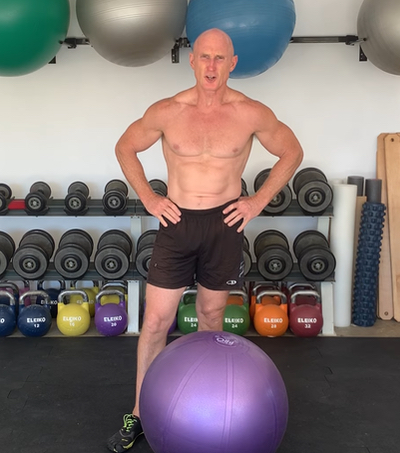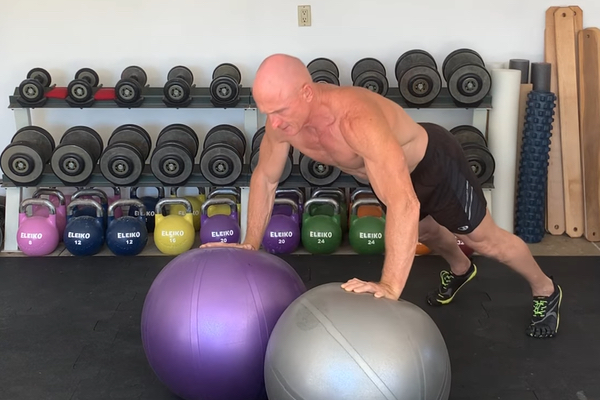
If you thought last week’s exercise video was a short break from more blackboard work or a podcast excerpt, we’re back in the gym FOR MORE!
A few months ago, I shared the Swiss Ball Reverse Crunch, an exercise that targets the lower abdominals. This week, I’m using the Swiss ball once again in combination with the push-up, an exercise that’s not as easy as it looks!
The Single Arm Swiss Ball Push-up creates a lot of torque through the spine, particularly in the working arm and opposite leg due to the angle of the obliques and the ways our bodies stabilize from one side to the other.
For example, if I place my right hand on the Swiss ball, the load will gravitate to the left leg due to the way the sling systems of the core work. If you want to know more about the sling systems in the body, I recommend my book Movement That Matters.
Adding a Swiss ball creates a lot more uncertainty because it moves in every direction, thus this exercise requires a lot more stabilization and neurological energy to perform it effectively.
Before we get started, if you can’t do a single arm push-up from the ground, you’re definitely not ready to do it with ONE Swiss ball.
A two-ball workaround
If you can’t do single arm push-up from the floor, one way you can build your strength is to do push-ups using TWO Swiss balls touching each other for better stability.
Be sure to use good postural alignment and lower your body down into the Swiss ball, adjusting your weight so it’s focused more on one hand than the other, then lean toward the other hand. In the early stages of performing this exercise, you can also promote good stability by keeping your legs spread wider apart.
As you build strength, you can progressively make the exercise harder by adding space between the two Swiss balls (and keep your legs closer together).
A BIGGER ball!
When you’re ready to try this single-arm exercise, my advice is to start by using a bigger ball. By using a bigger ball, the angle of your body isn’t as parallel to the floor so you aren’t pushing as much weight.
You’ll want to spread your legs fairly wide, again, for the sake of stability. Pushing with one arm could make the ball flip on you because the load is going through one arm.
Make sure your feet are positioned properly too. If they’re too close together, the Swiss ball may flip on you again and that could be tricky and possibly dangerous.
Ensure that your free hand is attached to the same leg while performing the push-up, and put some tone in your lats so you can keep your trunk as rigid as you can. Once you’ve built up enough core strength, you won’t need to keep doing it, but it’s still a wise thing to do.
You shouldn’t be doing this stupidly either. It’s worth repeating you can generate so much torque through your low back, if you don’t have a good stable core, your back may feel like it’s been hit with a lightning bolt and you’ll be laying on the floor in a world of pain. You could sublux an L4 or L5 vertebra and pinch a nerve root pretty easily.
When you’ve anchored your body, don’t forget to breathe and activate your core.
Working up to the SMALLER ball!

Otherwise, you’re maintaining a strength imbalance. Once that deficit surpasses the 10 percent mark, this can result in torsion on joint complexes and can lead to all sorts of mechanical and postural problems, as well as other challenges you really don’t want.
When you can perform 20 reps straight with each arm, you can start alternating arms with each repetition. That requires some coordination and balance, because this exercise can start moving very fast until you learn how to control it.
I finish up this video by showing you the next progression: How I perform this exercise with a ball that’s more appropriate for my height, a lot closer to the ground and much harder to do.
The slower you go, the harder this exercise will be. If you’re a beginner, however, you might want to let yourself fall into the ball a bit and use some of the rebound action from the ball as you’ll see in my vlog.

After you watch my video, you may be interested in learning a lot more…
I suggest my Strong ‘N’ Stable set of three DVDs, featuring more than 100 exercises that will strengthen your body and core and six sample workouts for a variety of athletes, from beginners to advanced weight lifters.
If you want to go deeper, you may want to consider our CHEK Integrated Movement Science Level 1 program, previously known as CHEK Exercise Coach.
I hope you have some fun with this exercise, but take it slow and take your time.
Love and chi,
Paul







